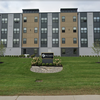GCSD plans a $31M project for May 21 vote
GUILDERLAND — The school board is considering bringing to the voters a pared-down $30.6 million capital construction project, reduced from the $42.7 million proposal defeated in October.
The median price for a home in the district is $326,000, school officials said, and annual taxes for the owner of that median home would be $65 annually for the 15-year life of the bond if the $30.6 million plan passes. That’s down from $103 annually for the defeated $42.7 million plan.
The vote will be held on the state-set date for school board and budget elections, May 21. Guilderland school district voters will also be deciding at the same time on a library budget and an $8 million project to upgrade the library.
Following last fall’s school bond defeat, the district divided the items in the original bond project into three priority levels. Undertaking only the top priority items, the capital project would total $30.6 million, district officials said during a presentation to the school board on Monday.
The board will hold a community question-and-answer workshop on March 12 at 7 p.m., and will meet again on March 19, when it plans to finalize a proposal.
The bond was defeated by 58 votes, with 1,317 voting for the project and 1,375 voting against. An anonymous flier issued a few days before the Oct. 16 election urged residents to vote no, calling the items a “wish list” and saying the estimates were inflated.
Board member Teresa Gitto said that she didn’t think any of the original items had been “a wish list.” She said, “It really all is a priority.”
Longtime board member Barbara Fraterrigo said that it seemed like “putting money down the drain” to do partial repairs but to defer other parts that are equally necessary when the district knows “it’s not going to be enough.”
President Christine Hayes suggested that if anyone wanted to restore items that had been deferred, they should be prepared to suggest cuts that could be made instead.
Sean Maguire concurred, saying, “If we’re going to put things back in, we have to ask, ‘What’s the trade-off?’”
Benjamin Goes said that if the board starts to put items back in, residents are likely to say, “You cut that, so obviously you don’t need it. Why put it back in?” Goes emphasized, “This has to be smaller. This has to be smaller.” As he spoke, member Timothy Horan nodded emphatically.
Horan said that he wants to discuss the security film to be placed on windows, but plans to wait until an upcoming meeting, so that he can express his thoughts as effectively as possible. Hayes asked him to submit something in writing in advance if possible, since there is only one week between the March 12 question-and-answer workshop with the community and the March 19 meeting at which the board hopes to finalize the numbers.
In September 2018, the board voted, 7 to 1, to approve sending the project to voters, with board vice-president Seema Rivera absent, and Horan voting against the proposition. At the time, Horan declined to comment about his reasons for voting against the project.
Fellow board member Gloria Towle-Hilt told The Enterprise at the time that she had been “shocked” by Horan’s vote and had “no hint” of why he opposed the project.
Before the last vote, Albany County Comptroller Michael Conners, held a press conference, standing outside of Guilderland High School to lambast the district for holding the vote on Oct. 16 rather than Nov. 6, and suggesting the district had done this to limit voter participation. In fact, the Albany County Board of Elections had instructed the district not to hold the vote on Nov. 6, since the boundaries of the election district and the town are not the same.
At Tuesday night’s school board meeting, Director of Facilities Clifford Nooney said the district will lower the project cost in two ways:
— By reducing costs through reengineering, redesign, or adjusting cost estimates; and
— By delaying or deferring needed work, in part or in full, into the future.
From the district’s capital reserve fund, $3.12 million will be applied to lower the amount borrowed for the project, Nooney said.
Cost adjustments were made that allowed the district to reduce the cost of the project by almost $2.9 million, but three issues emerged after the original project was proposed that are being recommended for inclusion in the revised project; the $400,000 cost of these additions brings the savings down to $2.5 million.
These additions included asbestos tile removal at Farnsworth Middle School, and replacement of the locksets in bathroom doors at the district’s five elementary schools. The lockset issue arose during lockdown drills when teachers and students would hide in bathrooms inside the classroom, and then refuse to open the door for police, thinking the drill was ongoing. District officials believe they need to be able to unlock those doors when necessary in an emergency.
Building repairs are being put through where absolutely needed immediately, Nooney said, and being put off where possible. Some repairs to the plumbing, electrical, and mechanical systems are being deferred, but many are being cited as top priority. Technology improvements are being split into different priority categories.
A few items, totalling $5 million, are recommended for expedited completion in the summer of 2020, “all tied to safety and security across our school district,” Nooney said.
These include:
— Replacing the phone system since the one currently in use is being phased out by the manufacturer and the district can no longer get new parts;
— Installing a fire alarm and public-announcement system that will include the ability to remotely control who can swipe into buildings in an emergency;
— Repairing and updating the existing fuel system;
— Installing the bathroom locksets; and
— Adding impact-resistant film for the glass portions of exterior doors.
The board on Tuesday discussed some specific items.
Someone asked about the current status of updating 12 high-school science labs, which are listed now as a top priority and at a total cost of $2.8 million. Demian Singleton, the district’s assistant superintendent of instruction, said that the labs were built in 1962 and are “not even remotely close to a state-of-the-art lab for our students.” The labs function, he said, but he worries about their safety and reliability.
“The piping, gas lines, have literally not been touched since the 1960s,” Singleton said.
Residents are feeling a number of financial stresses.
The town of Guilderland is currently undertaking a town-wide revaluation, the first since 2005, bringing property assessments in line with their full market value. The town signed on for cyclical revaluation after unsuccessfully challenging the state-set equalization rate that, in 2017, suddenly raised the taxes of town residents whose homes are in neighboring school districts.
On May 21, the Guilderland Public Library, which follows school-district boundaries, will also bring a bond project to the voters.
The library wants to update its 26-year-old building and expand it by about a quarter of its size, building an addition for a larger children’s room, creating a separate teen room for the first time, adding meeting rooms, adding a café near the entrance, reconfiguring the parking lot to slow traffic and make the lot safer for pedestrians, and making the library more comfortable and attractive throughout.
In addition, school district residents will vote on the annual budgets for the school and the library as well as electing board members for each institution. Those votes will also be on May 21.



